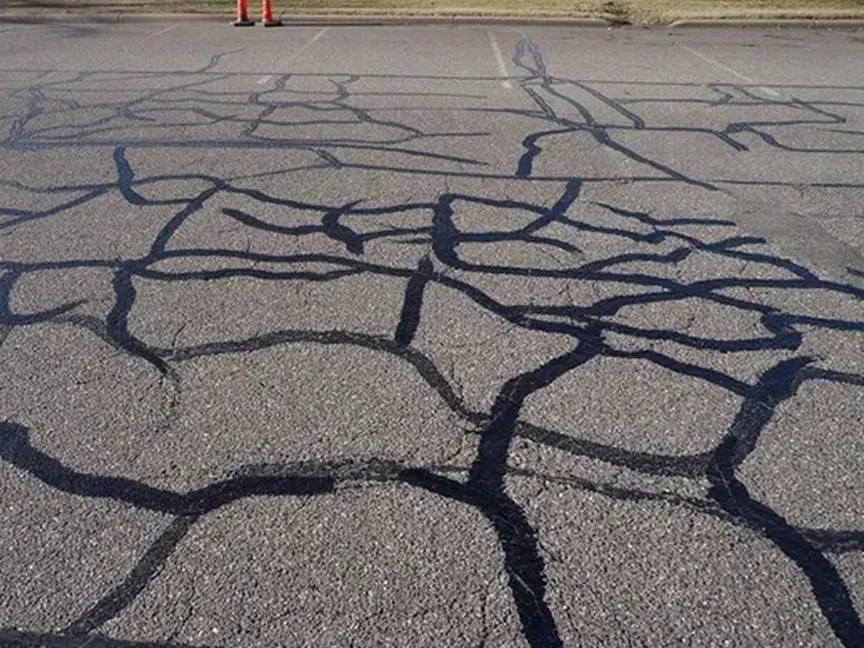Asphalt Crack Repair Guide! Asphalt surfaces, whether they’re driveways, parking lots, or roadways, are subject to wear and tear from traffic, weather conditions, and age. Cracks in asphalt not only detract from the appearance of your property but can also lead to more significant issues if left untreated. This comprehensive guide will walk you through how to prevent asphalt cracks and repair them effectively, ensuring the longevity and functionality of your asphalt surfaces.
Asphalt Crack Repair Guide
Before diving into prevention and repair, it’s important to understand why asphalt cracks occur:
- Weather Conditions: Extreme temperatures, whether hot or cold, can cause asphalt to expand and contract, leading to cracks.
- Traffic Stress: Heavy vehicles and constant traffic can put stress on asphalt surfaces, causing them to crack over time.
- Poor Installation: Inadequate installation practices or low-quality materials can lead to premature cracking.
- Aging: Over time, asphalt naturally deteriorates, making it more susceptible to cracking.

How to Prevent Asphalt Cracks
Preventing cracks before they appear is crucial for maintaining the integrity of your asphalt surfaces. Follow these tips to reduce the likelihood of cracks:
1. Regular Maintenance
Routine maintenance is essential to keep your asphalt in good condition. Schedule regular inspections and perform necessary maintenance tasks, such as sealing cracks and applying sealcoating. Sealcoating protects the asphalt from moisture and UV damage, reducing the risk of cracks.
2. Prompt Repairs
Address minor cracks and damage as soon as they appear. Prompt repairs prevent small issues from escalating into larger problems. Use a crack filler or sealant to fill in small cracks before they have a chance to widen.
3. Proper Drainage
Ensure that your asphalt surface has proper drainage to prevent water from pooling and seeping into the cracks. Proper drainage helps avoid moisture-related damage and reduces the risk of cracks forming.
4. Avoid Heavy Loads
Be mindful of the weight limits on your asphalt surface. Avoid parking heavy vehicles or equipment on the surface to prevent stress and damage that can lead to cracking.
5. Avoid Standing Water
Water can cause significant damage to asphalt surfaces. Make sure your asphalt surface is designed to direct water away and avoid standing water, which can contribute to cracking.

How to Repair Asphalt Cracks
If cracks have already formed in your asphalt surface, timely and effective repair is essential. Follow these steps to repair asphalt cracks:
1. Clean the Crack
Begin by cleaning the crack to remove any debris, dirt, or loose material. Use a wire brush or a broom to clear out the crack thoroughly. For more stubborn debris, a pressure washer or air blower may be needed. A clean crack ensures proper adhesion of the repair material.
2. Prepare the Crack
For larger cracks or potholes, you may need to use a cold patch or hot asphalt mix. For small cracks, use a crack filler or sealant. Follow the manufacturer’s instructions for preparation, which may involve heating the filler or mixing it with a bonding agent.
3. Apply the Repair Material
Apply the chosen repair material into the crack, using a caulk gun or trowel for precision. For small cracks, fill the crack with the repair material and smooth it out to level it with the surrounding surface. For larger cracks, apply the material in layers, allowing each layer to dry before applying the next.
4. Smooth and Finish
Once the repair material is applied, smooth the surface with a trowel or putty knife to ensure a level finish. For larger repairs, you may need to use a tamping tool to compact the material and ensure a solid repair.
5. Allow to Cure
After applying the repair material, allow it to cure according to the manufacturer’s instructions. Curing times can vary based on the type of material used and weather conditions. Avoid using the repaired area until it is fully cured to ensure a durable and long-lasting repair.
6. Seal the Surface
Once the crack repair is complete and fully cured, consider applying a sealcoat to the entire asphalt surface. Sealcoating provides an additional layer of protection against moisture and UV damage, helping to prevent future cracks.
Why Choose Discount Pothole & Sealing
At Discount Pothole & Sealing, we specialize in expert asphalt crack repair and prevention. Our experienced team uses high-quality materials and advanced techniques to ensure your asphalt surfaces remain in top condition. Whether you need crack repair, sealcoating, or routine maintenance, we provide reliable and professional services tailored to your needs.
Contact Discount Pothole & Sealing today to get started with your asphalt crack repair. Follow our Asphalt Crack Repair Guide to keep your asphalt surfaces in excellent condition and extend their lifespan. Get a free estimate and let us help you maintain a smooth, durable, and visually appealing asphalt surface!

